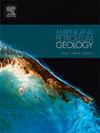孟加拉东北部扇形海域深水航道的中新世演化:来自源区的喜马拉雅隆升和南亚季风信号记录
IF 3.7
2区 地球科学
Q1 GEOSCIENCES, MULTIDISCIPLINARY
引用次数: 0
摘要
海底通道是向深海输送陆地沉积物的主要通道,对源区抬升和气候变化非常敏感。利用新的三维地震数据、以前公布的古环境数据以及 IODP/ODP 数据,我们描述了孟加拉湾东北部深水通道的地层时间变化特征,并提出其长期演变与喜马拉雅隆升和南亚季风的同期变化有关。我们的研究结果表明,在中新世和上新世的交界处,深水通道的沉积特征与喜马拉雅山隆升速度的降低和季风气候的变化几乎同时发生变化。这强烈表明,环境信号可以成功地从喜马拉雅山传播到深海,并对深水航道的长期演化起着主导控制作用。在中新世晚期,造山带范围内喜马拉雅山的大幅度隆升和潮湿的季风气候(夏季季风占主导地位)产生了高通量的沉积物供应,使颗粒较粗的沉积物能够进一步进入盆地,从而形成了具有崩蚀和汇流现象的更大规模的非剥蚀河道。中新世之后,喜马拉雅山局部和有限的隆起以及干旱的季风气候(冬季季风占主导地位)导致沉积物供应量较低,在此期间,只有较细粒度的沉积物进入深水区,从而形成了规模较小、有堤岸的侵蚀性河道,这些河道主要有劈裂沉积。在中新世晚期和中新世晚期之间,IODP 岩心孟加拉湾扇样品的锆英石 U-Pb 年龄反映了沉积物来源的变化,即从雅鲁藏布江和恒河的混合到雅鲁藏布江的末段,这与喜马拉雅山隆升和南亚季风的变化大致同时期。此外,孟加拉扇形岩芯记录了中更新世沉积速率和最大粒径的减小以及泥岩含量的增加,这与源流域沉积物产量的变化是一致的。因此,本研究的观察结果和解释有助于更好地理解海底河道的长期演变如何对源头地区的构造和气候扰动做出反应,并可能有助于在其他地区认识类似的过程-反应关系。本文章由计算机程序翻译,如有差异,请以英文原文为准。
Mio-pliocene evolution of deep-water channels on the northeastern Bengal fan: Records of signals of Himalaya uplift and South Asian Monsoon from source areas
Submarine channels, acting as major conduits for delivering terrestrial sediments into the deep sea, are sensitive to source-region uplift and climate variations. Using new 3D seismic data, previously published paleoenvironmental data, and IODP/ODP data, we characterize stratigraphic time changes in deep-water channels on the northeastern Bengal Fan and suggest that their long-term evolution relates to contemporaneous changes of Himalaya uplift and South Asian Monsoon. Our results show that around the boundary between the Miocene and Pliocene Epochs, the sedimentary characteristics of deep-water channels were changing at about the same time as decreased rates of Himalaya uplift and changes in the monsoonal climate. It is strongly suggested that environmental signals could successfully propagate from the Himalaya to the deep sea and play a dominant control on the long-term evolution of deep-water channels. During the late Miocene, orogen-wide and substantial Himalaya uplift and humid monsoonal climates (dominance of summer monsoon) generated a sediment supply with high fluxes, which allowed coarser-grained sediments to reach further into the basin and thus caused the formation of larger-scale, non-leveed erosional channels that have avulsion and confluence phenomena. After the Miocene, local and limited Himalaya uplift and arid monsoonal climates (dominance of winter monsoon) led to a sediment supply with low fluxes, during which only finer-grained sediments reached deep water and gave rise to smaller-scale, leveed aggradational channels that mainly have splay deposits. Between the late-Miocene and post-Miocene periods, detrital zircon U-Pb ages of Bengal Fan samples from IODP cores reflect a sediment provenance change from the mixing of Brahmaputra and Ganges Rivers to the end-member of Brahmaputra River, broadly coeval with the variations of Himalaya uplift and South Asian Monsoon. Moreover, Bengal Fan cores record a Mio-Pliocene decrease in sedimentation rates and maximum grain sizes and an increase in mudstone contents, consistent with the variations of sediment yield in the source catchments. Observations and interpretations from the current study, therefore, contribute to a better understanding of how the long-term evolution of submarine channels respond to tectonic and climatic perturbations in source areas and may help recognizing similar process-response relationships in other areas.
求助全文
通过发布文献求助,成功后即可免费获取论文全文。
去求助
来源期刊

Marine and Petroleum Geology
地学-地球科学综合
CiteScore
8.80
自引率
14.30%
发文量
475
审稿时长
63 days
期刊介绍:
Marine and Petroleum Geology is the pre-eminent international forum for the exchange of multidisciplinary concepts, interpretations and techniques for all concerned with marine and petroleum geology in industry, government and academia. Rapid bimonthly publication allows early communications of papers or short communications to the geoscience community.
Marine and Petroleum Geology is essential reading for geologists, geophysicists and explorationists in industry, government and academia working in the following areas: marine geology; basin analysis and evaluation; organic geochemistry; reserve/resource estimation; seismic stratigraphy; thermal models of basic evolution; sedimentary geology; continental margins; geophysical interpretation; structural geology/tectonics; formation evaluation techniques; well logging.
 求助内容:
求助内容: 应助结果提醒方式:
应助结果提醒方式:


